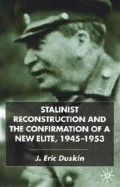Abstract
Stalin’s postwar system marked the Soviet Union’s passage from the convulsion and disorder of revolution to the routinized professionalization common to most industrial societies. In the late Stalin years the career paths offering status and security became more clearly delineated, and for industrial supervisors, their families, and even their employees, life became more predictable. The stability and emerging normalcy of the era were new and welcomed phenomena in Soviet history. Unlike the situation in the 1930s, radical change and social upheaval were not part of the late Stalinist landscape. In the Introduction I asked if something about the postwar experience might have helped build popular acceptance or tolerance for Stalin’s regime. This study of elite formation indicates that the job security and enhanced status enjoyed by postwar technicians and engineers may well have inclined the technical intelligentsia to develop a fondness for Stalinism, at least in its postwar manifestation.
Access this chapter
Tax calculation will be finalised at checkout
Purchases are for personal use only
Preview
Unable to display preview. Download preview PDF.
Notes
This observation has been documented by Jerry F. Hough in The Soviet Prefects: The Local Party Organs in Industrial Decision-making (Cambridge, Mass.: Harvard University Press, 1969), pp. 40–43.
N. S. Khrushchev, Khrushchev Remembers, trans. Strobe Talbott (Boston: Little, Brown, 1970), p. 257.
See Lars T. Lih, Oleg V. Naumov, and Oleg V. Khlevniuk, eds., Stalin’s Letters to Molotov (New Haven: Yale University Press, 1995), pp. 224–240.
Yoram Gorlizki, “Party Revivalism and the Death of Stalin”, Slavic Review 54, no. 1 (Spring 1995), p. 11
Amy Knight, Beria: Stalin’ s First Lieutenant (Princeton: Princeton University Press, 1993), p. 144.
Milovan Djilas, Conversations with Stalin, trans. Michael B. Petrovich (New York: Harcourt, Brace and World, 1962), pp. 151–152.
Khrushchev, Khrushchev Remembers, p. 299. Khrushchev’s comment about the war is quoted in Robert Conquest, Stalin: Breaker of Nations (New York: Praeger, 1976), p. 269.
Vladislav Zubok and Constantine Pleshakov, Inside the Kremlin’s Cold War (Cambridge, Mass.: Harvard University Press, 1996), pp. 64–65.
Alexander Werth, Russia: The Post-War Years (New York: Taplinger, 1971), p. 158.
Elena Zubkova, Russia After the War: Hopes, Illusions, and Disappointments, 1945–1957 (Armonk, N.Y.: M. E. Sharpe, 1998).
Important works highlighting Stalinism’s multifaceted nature include Giuseppe Boffa, The Stalin Phenomenon (Ithaca, N.Y.: Cornell University Press, 1992)
Alec Nove, ed., The Stalin Phenomenon (London: Weidenfeld and Nicolson, 1993)
Robert C. Tucker, ed., Stalinism: Essays in Historical Interpretation (New York: Norton, 1977).
Seweryn Bialer, Stalin’s Successors: Leadership, Stability, and Change in the Soviet Union (New York: Cambridge University Press, 1984), p. 180.
For a study of Party schools, see Michael David-Fox, Revolution of the Mind: Higher Learning among the Bolsheviks, 1918–1929 (Ithaca, N.Y.: Cornell University Press, 1997).
Nicholas DeWitt, Education and Professional Employment in the USSR (Washington: National Science Foundation, 1961), p. 534.
Moshe Lewin, Stalinism and the Seeds of Soviet Reform: The Debates of the 1960s (Armonk, N.Y.: M. E. Sharpe, 1974), p. 136.
Stephen Whitefield, Industrial Power and the Soviet State (New York: Oxford University Press, 1993).
Author information
Authors and Affiliations
Copyright information
© 2001 J. Eric Duskin
About this chapter
Cite this chapter
Duskin, J.E. (2001). The Implications of Stalin’s Technocracy. In: Stalinist Reconstruction and the Confirmation of a New Elite, 1945–1953. Palgrave Macmillan, London. https://doi.org/10.1057/9781403919458_6
Download citation
DOI: https://doi.org/10.1057/9781403919458_6
Publisher Name: Palgrave Macmillan, London
Print ISBN: 978-1-349-42392-7
Online ISBN: 978-1-4039-1945-8
eBook Packages: Palgrave History CollectionHistory (R0)

